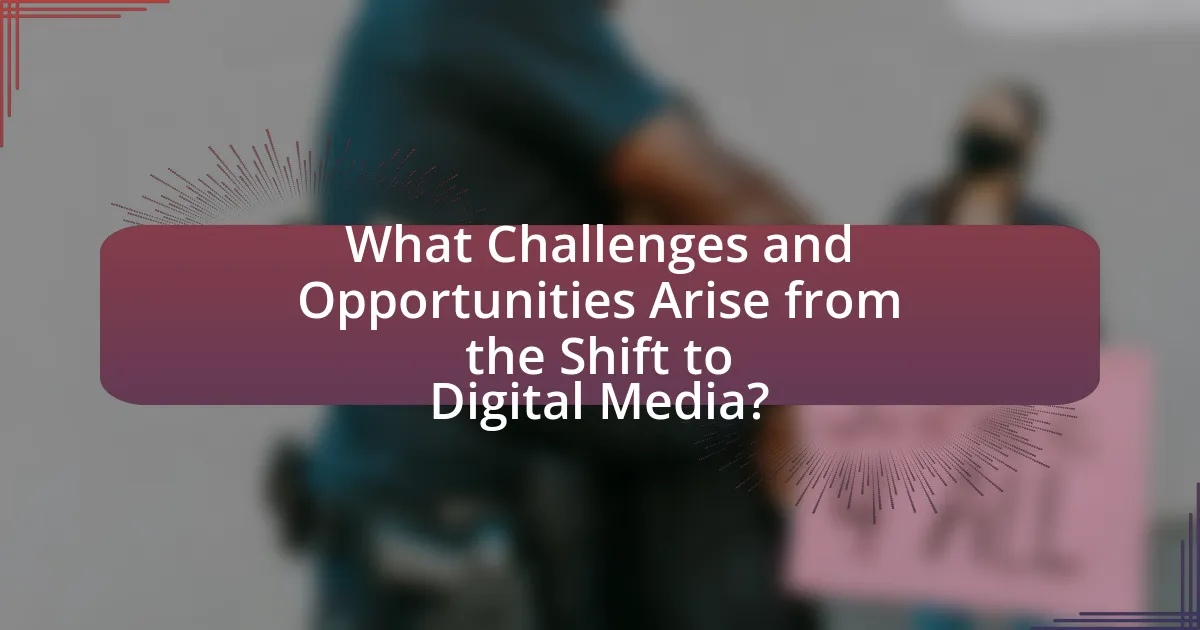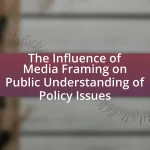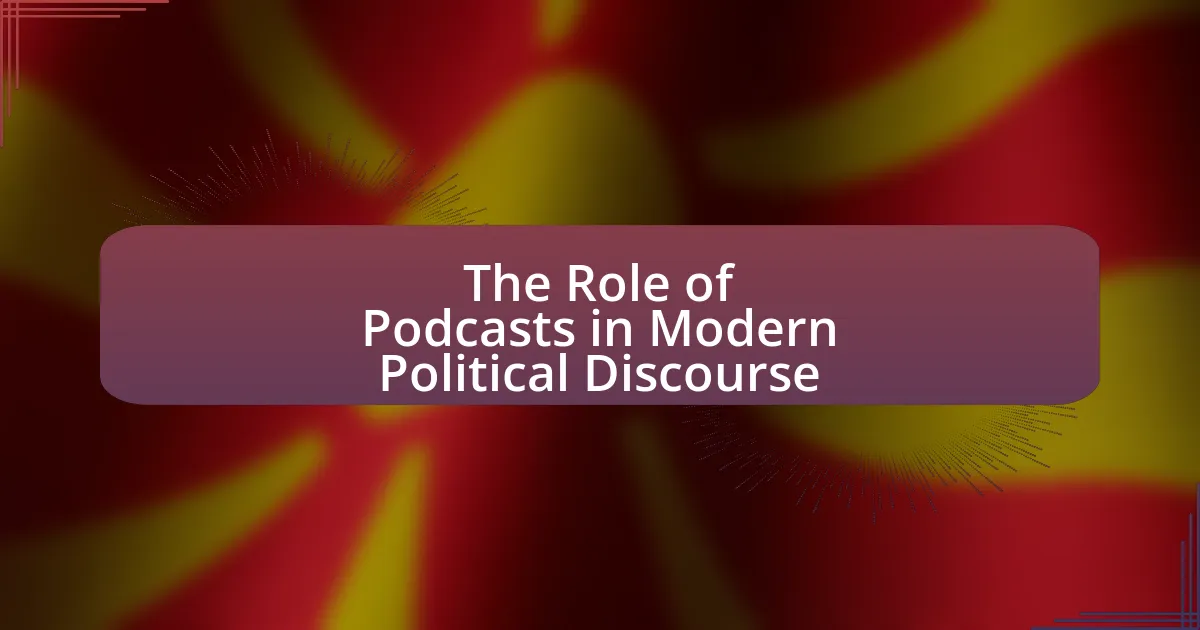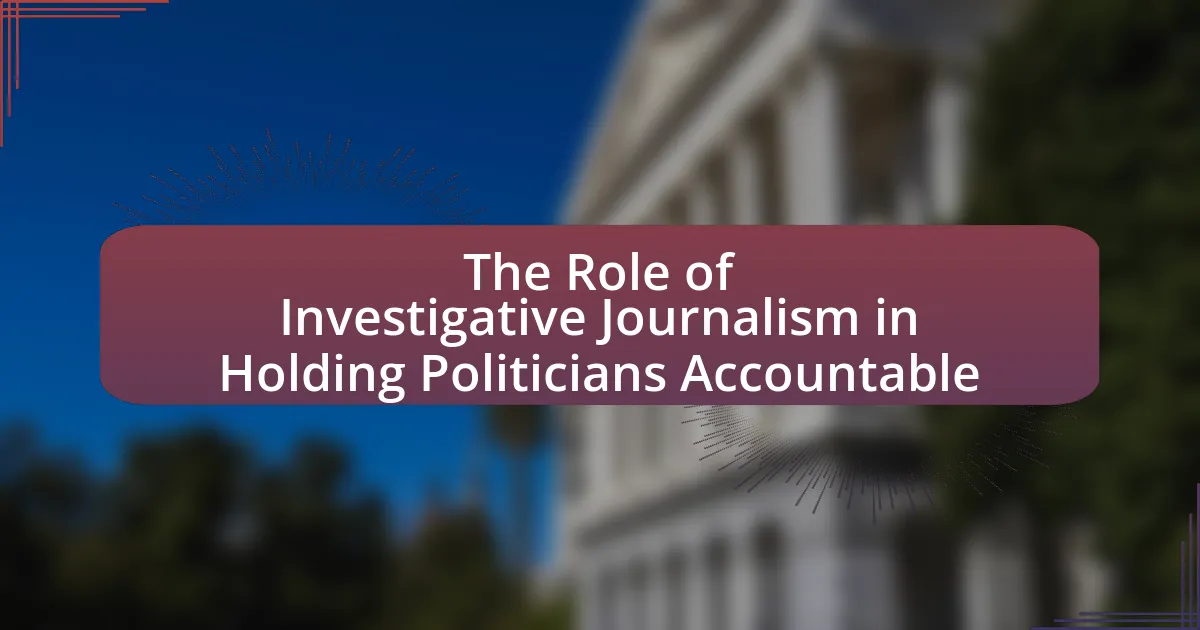The article analyzes the significant shift from traditional to digital media in political campaigns, highlighting how candidates increasingly rely on online platforms and social media for outreach and engagement. It discusses the evolution of political campaigning, the defining characteristics of both traditional and digital media, and the implications of changing media consumption habits. Key factors driving this transition include the rise of social media, technological advancements, and demographic trends favoring digital engagement. The article also addresses the challenges and opportunities presented by digital media, including issues related to misinformation, privacy concerns, and strategies for effective voter mobilization.

What is the Shift from Traditional to Digital Media in Political Campaigns?
The shift from traditional to digital media in political campaigns refers to the transition where political candidates increasingly utilize online platforms and social media for outreach, engagement, and advertising instead of relying solely on conventional methods like television, radio, and print. This change has been driven by the growing internet penetration and the ability of digital media to target specific demographics effectively. For instance, a 2020 Pew Research Center study indicated that 72% of Americans use social media, making it a crucial tool for political communication. Additionally, digital campaigns allow for real-time feedback and interaction, enhancing voter engagement compared to traditional media, which is often one-directional.
How has the landscape of political campaigning evolved over time?
The landscape of political campaigning has evolved significantly from traditional methods to digital platforms. Historically, campaigns relied on print media, radio, and television to reach voters, with strategies focused on direct mail and in-person events. The advent of the internet in the late 20th century introduced new avenues for engagement, allowing campaigns to utilize websites and email outreach. By the 2008 presidential election, social media platforms like Facebook and Twitter became integral, enabling real-time communication and targeted advertising. This shift has led to increased voter engagement, with data analytics allowing campaigns to tailor messages to specific demographics, as evidenced by Barack Obama’s successful use of digital strategies in 2008, which set a precedent for future elections.
What are the defining characteristics of traditional media in political campaigns?
Traditional media in political campaigns is characterized by its reliance on established channels such as television, radio, newspapers, and magazines to disseminate information. These media forms provide a broad reach, allowing campaigns to target diverse demographics effectively. For instance, television ads can reach millions of viewers simultaneously, while newspapers offer in-depth coverage and analysis of political issues. Additionally, traditional media often emphasizes professional journalism standards, which can lend credibility to the information presented. Historical data shows that during the 2008 U.S. presidential election, over 60% of campaign spending was allocated to television advertising, highlighting its significance in shaping public perception and voter behavior.
What are the defining characteristics of digital media in political campaigns?
Digital media in political campaigns is characterized by interactivity, real-time communication, targeted advertising, and data analytics. Interactivity allows voters to engage directly with candidates through social media platforms, fostering a two-way communication channel. Real-time communication enables campaigns to respond swiftly to events and public sentiment, enhancing their relevance. Targeted advertising utilizes data analytics to reach specific demographics, ensuring that messages resonate with particular voter segments. According to a 2020 study by the Pew Research Center, 69% of Americans reported using social media for political news, highlighting the significant role digital media plays in shaping political discourse.
Why is the shift to digital media significant for political campaigns?
The shift to digital media is significant for political campaigns because it enhances voter engagement and allows for targeted messaging. Digital platforms enable campaigns to reach specific demographics through data analytics, which can increase the effectiveness of outreach efforts. For instance, a study by the Pew Research Center in 2020 found that 53% of U.S. adults reported getting news from social media, highlighting the importance of these platforms in shaping public opinion. Additionally, digital media allows for real-time communication and feedback, fostering a more interactive relationship between candidates and voters. This shift has fundamentally transformed how campaigns strategize and allocate resources, making digital presence a crucial element for success in modern political landscapes.
How does digital media enhance voter engagement compared to traditional media?
Digital media enhances voter engagement compared to traditional media by providing interactive platforms that facilitate direct communication and real-time feedback. Unlike traditional media, which often relies on one-way communication, digital media allows voters to engage with candidates through social media, websites, and mobile applications, fostering a more participatory environment. For instance, a study by the Pew Research Center found that 69% of adults in the U.S. use social media, which candidates leverage to share information, respond to voter inquiries, and mobilize supporters quickly. This immediacy and interactivity significantly increase voter involvement and awareness, making digital media a more effective tool for engagement in political campaigns.
What role does social media play in modern political campaigns?
Social media serves as a crucial platform for modern political campaigns by enabling direct communication between candidates and voters. It allows campaigns to disseminate information rapidly, engage with constituents in real-time, and mobilize supporters through targeted advertising and grassroots organizing. According to a Pew Research Center study, 69% of adults in the U.S. use social media, making it an essential tool for reaching a broad audience. Additionally, social media facilitates the viral spread of campaign messages, as seen in the 2016 U.S. presidential election, where platforms like Twitter and Facebook played significant roles in shaping public discourse and influencing voter perceptions.

What are the Key Factors Driving the Shift to Digital Media?
The key factors driving the shift to digital media include the increasing accessibility of the internet, the rise of social media platforms, and the changing consumption habits of audiences. The widespread availability of smartphones and high-speed internet has enabled more people to access digital content, with over 4.9 billion internet users globally as of 2021. Social media platforms, such as Facebook and Twitter, have become essential tools for political campaigns, allowing for direct engagement with voters and real-time communication. Additionally, audiences are increasingly consuming news and information online, with studies showing that over 60% of adults in the U.S. prefer digital news sources over traditional print media. These factors collectively contribute to the growing reliance on digital media in political campaigns.
How do changes in technology influence political campaigning?
Changes in technology significantly influence political campaigning by enabling more targeted communication and engagement with voters. Digital platforms allow campaigns to analyze voter data, tailoring messages to specific demographics, which increases the effectiveness of outreach efforts. For instance, the 2008 Obama campaign utilized social media and data analytics to mobilize young voters, resulting in a 66% turnout rate among that demographic, compared to 50% in previous elections. This shift from traditional media to digital channels has transformed how candidates interact with constituents, making campaigns more dynamic and responsive to public sentiment.
What technological advancements have impacted political communication?
Technological advancements such as the internet, social media, and mobile communication have significantly impacted political communication. The internet has enabled instant access to information and facilitated the rapid dissemination of political messages, allowing candidates to reach a broader audience. Social media platforms like Twitter and Facebook have transformed how politicians engage with constituents, enabling direct interaction and real-time feedback. Mobile communication has further enhanced this by allowing voters to receive updates and participate in campaigns through their smartphones. According to a Pew Research Center study, 69% of Americans use social media, which has become a crucial tool for political engagement and mobilization. These advancements have shifted political communication from traditional media channels to more interactive and immediate forms, fundamentally altering the landscape of political campaigns.
How do data analytics shape campaign strategies in the digital age?
Data analytics significantly shape campaign strategies in the digital age by enabling targeted messaging and optimizing resource allocation. Campaigns utilize data analytics to analyze voter behavior, preferences, and demographics, allowing for personalized communication that resonates with specific audiences. For instance, a study by the Pew Research Center found that 70% of voters are influenced by tailored advertisements based on their online behavior. This data-driven approach enhances engagement and increases the likelihood of voter turnout, as campaigns can focus their efforts on segments most likely to respond positively. Additionally, real-time analytics allow campaigns to adjust strategies dynamically, ensuring that messaging remains relevant and effective throughout the election cycle.
What demographic trends are influencing the shift to digital media?
The demographic trends influencing the shift to digital media include the increasing prevalence of younger generations, particularly Millennials and Gen Z, who are more inclined to consume content online rather than through traditional media. According to a Pew Research Center study, 95% of teenagers have access to a smartphone, and 45% are online almost constantly, highlighting their preference for digital platforms. Additionally, urbanization trends show that individuals in urban areas are more likely to engage with digital media, as they have better access to high-speed internet and digital devices. This demographic shift is further supported by the growing diversity in the population, which often leads to varied media consumption habits that favor digital channels over traditional ones.
How do younger voters interact with political content online?
Younger voters interact with political content online primarily through social media platforms, where they engage with, share, and comment on political posts. Research indicates that 70% of younger voters use social media as their primary source for political information, significantly influencing their political opinions and engagement. This demographic tends to favor visual content, such as videos and infographics, which are more likely to be shared and discussed among peers, amplifying their reach and impact. Additionally, younger voters often participate in online discussions and activism, utilizing hashtags and online campaigns to mobilize support for issues they care about, further demonstrating their active engagement with political content in the digital space.
What are the implications of changing media consumption habits for campaigns?
Changing media consumption habits significantly impact campaigns by necessitating a shift from traditional advertising methods to digital strategies. As audiences increasingly favor online platforms over television and print, campaigns must adapt to engage voters through social media, targeted ads, and digital content. For instance, a Pew Research Center study indicates that 72% of Americans use social media, highlighting the importance of these platforms for reaching potential voters. Consequently, campaigns that fail to embrace digital media risk losing relevance and effectiveness in their outreach efforts.

What Challenges and Opportunities Arise from the Shift to Digital Media?
The shift to digital media presents significant challenges and opportunities for political campaigns. Challenges include the need for campaigns to adapt to rapidly changing technologies and platforms, which can lead to resource allocation issues and the risk of misinformation spreading quickly. For instance, a study by the Pew Research Center found that 64% of Americans believe that fake news causes confusion about the basic facts of current events, highlighting the difficulty campaigns face in maintaining credibility.
Conversely, opportunities arise from the ability to reach a broader audience through targeted advertising and social media engagement. Digital platforms allow campaigns to analyze voter data effectively, enabling personalized messaging that can increase voter turnout. According to a report by the Digital Advertising Alliance, digital ad spending in political campaigns reached $1.4 billion in 2020, illustrating the growing reliance on digital strategies to engage voters.
What challenges do political campaigns face when transitioning to digital media?
Political campaigns face several challenges when transitioning to digital media, including the need for new skill sets, data privacy concerns, and the rapid pace of technological change. Campaign teams often lack expertise in digital marketing and analytics, which are crucial for effective online engagement. Additionally, navigating data privacy regulations, such as the General Data Protection Regulation (GDPR), complicates how campaigns collect and use voter information. The fast-evolving nature of digital platforms requires campaigns to continuously adapt their strategies, making it difficult to maintain a consistent message. These challenges can hinder the effectiveness of digital outreach efforts and impact overall campaign success.
How do misinformation and fake news affect digital political campaigns?
Misinformation and fake news significantly undermine digital political campaigns by distorting public perception and influencing voter behavior. Research indicates that false information spreads faster and reaches more people than factual news, as demonstrated by a 2018 study published in Science, which found that false news stories are 70% more likely to be retweeted than true stories. This rapid dissemination can lead to the polarization of opinions, as voters may base their decisions on misleading narratives rather than factual information. Furthermore, misinformation can erode trust in legitimate sources, complicating the ability of campaigns to communicate effectively with their audience.
What are the privacy concerns associated with digital campaigning?
Privacy concerns associated with digital campaigning include the unauthorized collection and use of personal data, which can lead to breaches of individual privacy. Digital campaigns often rely on data analytics to target voters, raising issues about consent and transparency in how personal information is gathered and utilized. For instance, the Cambridge Analytica scandal highlighted how data from millions of Facebook users was harvested without consent for political advertising, demonstrating the potential for misuse of personal data in digital campaigning. Additionally, the lack of stringent regulations governing data privacy in many jurisdictions exacerbates these concerns, as individuals may not be aware of how their information is being used or shared.
What opportunities does digital media present for political campaigns?
Digital media presents significant opportunities for political campaigns by enabling targeted outreach, real-time engagement, and cost-effective advertising. Campaigns can utilize data analytics to identify and reach specific voter demographics, enhancing the effectiveness of their messaging. For instance, platforms like Facebook and Google allow campaigns to tailor ads based on user behavior and preferences, resulting in higher engagement rates. Additionally, digital media facilitates direct communication between candidates and voters through social media, fostering a sense of community and immediacy. According to a 2020 Pew Research Center study, 53% of voters reported that social media influenced their political views, highlighting the impact of digital platforms on voter perception and mobilization.
How can campaigns leverage digital platforms for fundraising?
Campaigns can leverage digital platforms for fundraising by utilizing social media, email marketing, and crowdfunding websites to reach a broader audience and engage potential donors effectively. Social media platforms like Facebook and Twitter allow campaigns to create targeted advertisements and share compelling stories that resonate with supporters, leading to increased donations. Email marketing enables campaigns to communicate directly with their supporters, providing updates and calls to action that encourage contributions. Crowdfunding websites, such as GoFundMe or Kickstarter, facilitate easy donation processes and allow campaigns to showcase their goals and progress, attracting small-dollar donations from a large number of individuals. According to a report by the Pew Research Center, 69% of adults in the U.S. use social media, highlighting the potential reach campaigns have through these platforms for fundraising efforts.
What strategies can campaigns use to effectively reach and mobilize voters online?
Campaigns can effectively reach and mobilize voters online by utilizing targeted social media advertising, engaging content creation, and data-driven outreach strategies. Targeted social media advertising allows campaigns to reach specific demographics based on interests, behaviors, and location, which has been shown to increase voter engagement significantly. For instance, a study by the Pew Research Center found that 69% of adults in the U.S. use Facebook, making it a crucial platform for voter outreach. Engaging content creation, such as videos, infographics, and interactive posts, captures attention and encourages sharing, thereby expanding the campaign’s reach organically. Additionally, data-driven outreach strategies, including email marketing and personalized messaging, enable campaigns to tailor their communication to individual voters, enhancing the likelihood of mobilization. According to a report by the Digital Campaigning Lab, campaigns that employed personalized outreach saw a 20% increase in voter turnout compared to those that did not.
What Best Practices Should Campaigns Follow in Digital Media Engagement?
Campaigns should prioritize audience targeting, content relevance, and engagement metrics in digital media engagement. Effective audience targeting ensures that messages reach the right demographics, increasing the likelihood of interaction. For instance, utilizing data analytics tools can help identify specific voter segments, allowing campaigns to tailor their messaging accordingly.
Creating relevant content that resonates with the audience is crucial; campaigns should focus on storytelling and emotional appeal to foster connections. Research indicates that emotionally charged content can increase sharing rates by up to 30%, enhancing visibility and engagement.
Finally, monitoring engagement metrics such as click-through rates, shares, and comments allows campaigns to assess the effectiveness of their strategies and make necessary adjustments in real-time. According to a study by the Pew Research Center, campaigns that actively engage with their audience through comments and social media interactions see a 50% increase in voter interest.





